|
|
|
Sort Order |
|
|
|
Items / Page
|
|
|
|
|
|
|
| Srl | Item |
| 1 |
ID:
112917


|
|
|
|
|
| Publication |
2012.
|
| Summary/Abstract |
This paper explores the relationship between CO2 emissions and economic activity for 31 countries (28 OECD, Brazil, China, and India) during the period 1950 to 2006 using cointegration analysis. Single country long run relationships are estimated, and equality in the functional form, the parameters, and the turning point, when appropriate, are rejected. This confirms the relevance of considering the differences among countries in the relationship between air pollution and economic activity to avoid wrong estimations and conclusions.
|
|
|
|
|
|
|
|
|
|
|
|
|
|
|
|
| 2 |
ID:
127831


|
|
|
|
|
| Publication |
2014.
|
| Summary/Abstract |
Revisiting the theory of institutional hybridity and diversity developed by Vincent and Elinor Ostrom to cope with the challenge of the "neither states nor markets" institutional domain, this article reconstructs the Ostromian system along the "value heterogeneity-co-production-polycentricity" axis. It articulates the elements of a theory of value heterogeneity and of the fuzzy boundaries between private and public. It rebuilds the model of co-production, clarifying the ambiguity surrounding a key technical public choice theoretical assumption, and it demonstrates (a) why it should not be confused with the Alchian-Demsetz team production model and (b) how co-production engenders a type of market failure that has been neglected so far. In light of this analysis, the article reconsiders polycentricity, the capstone of the Ostromian system, explaining why polycentricity may be seen as a solution both to this co-production market failure problem and to the problems of social choice in conditions of deep heterogeneity. It also discusses further normative corollaries.
|
|
|
|
|
|
|
|
|
|
|
|
|
|
|
|
| 3 |
ID:
159056
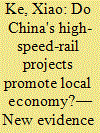

|
|
|
|
|
| Summary/Abstract |
This paper evaluates the effect of High Speed Rail (HSR) projects on the economic growth of targeted city nodes (HSR cities) in China using prefectural-level city data from 1990 to 2013. Employing a panel data program evaluation method devised by Hsiao, Ching, and Wan (2012), we construct hypothetical counterfactuals for per capita real GDP of HSR cities in the absence of their respective HSR projects using the outcomes in selected non-HSR cities. We find that the responses to HSR treatment are heterogeneous with regard to location, route, and region. The location-level impact ranges between 5% and 59% and is not temporary. HSR cities with positive effects concentrate along the Hu-Ning Segment, the Yong-Tai-Wen-Fu-Xia Segment, and within the Hunan province along the Wu-Guang HSR. These cities are mainly located in the eastern coastal regions of China, in core urban agglomeration regions that allow them to be transportation hubs. In general, the gain for local economies is greater for cities that are more industrialized, with more ability of the service sector to absorb enough labor, and with better supporting infrastructure. On the other hand, local protectionism hampers the development of HSR cities. We also show that at different project stages, HSR cities experience different gains.
|
|
|
|
|
|
|
|
|
|
|
|
|
|
|
|
| 4 |
ID:
129494


|
|
|
|
|
| Publication |
2014.
|
| Summary/Abstract |
This study revisits the causal linkages between military spending and economic growth in China and G7 countries (i.e. Canada, France, Germany, Italy, Japan, the UK, and the USA) by focusing country-specific analysis for the period 1988-2010. The panel causality analysis, which accounts for both cross-country dependency and heterogeneity across countries, is employed in this study. Our results find evidence of the neutrality hypothesis for Italy, France, and Germany, the military spending-growth detriment hypothesis for both Canada and the UK, and one-way Granger causality running from economic growth to military spending for China. Furthermore, we find a feedback between military spending and economic growth in both Japan and the USA. Thus, our results do not support that one size fits all.
|
|
|
|
|
|
|
|
|
|
|
|
|
|
|
|
| 5 |
ID:
100585
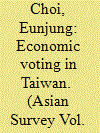

|
|
|
|
|
| Publication |
2010.
|
| Summary/Abstract |
An analysis of the 1996 and 2004 Taiwan presidential elections demonstrates that the voters' overall economic experiences under the dominant Kuomintang and level of education mediated the effect of short-term economic conditions on individual vote choice before and after the first power transition.
|
|
|
|
|
|
|
|
|
|
|
|
|
|
|
|
| 6 |
ID:
177121


|
|
|
|
|
| Summary/Abstract |
Reforming subsidies for fossil fuels is a challenging prospect for many governments. The impact of such a reform on households is a major concern for the government. This paper investigates the heterogeneous impacts of eliminating energy subsidies on households in China from direct and indirect perspectives. The results of the direct effects show that the removal of energy subsidies, particularly for removing electricity and gas subsidies, has a greater negative impact on the poor than on the rich. From an indirect perspective, this article shows that the lower the per capita disposable income, the higher the proportion of consumption to disposable income, and the greater the indirect impact of eliminating subsidies. Meanwhile, the impact is not only related to household income but consumer goods. Moreover, the indirect effects of eliminating subsidies on households differ across energy types. Specifically, eliminating electricity subsidies has the greatest effect on households, followed by transportation fuel and gas. We suggest that targeted supportive measures need to be taken towards the implementation of subsidy reform, particularly in countries with greater inequality, to minimize the negative effects on the poor.
|
|
|
|
|
|
|
|
|
|
|
|
|
|
|
|
| 7 |
ID:
162928
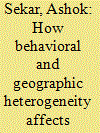

|
|
|
|
|
| Summary/Abstract |
The economic and environmental benefits of efficiency are typically assessed assuming that all consumers use appliances in the same way. There are, however, significant differences in consumer usage patterns, as well as geographical variability in prices and environmental impacts of electricity. To explore the importance of heterogeneity, we first develop distributions of consumer-by-consumer economic benefits from purchasing an efficient versus standard appliance for televisions, clothes washers, and dryers in the U.S. We find large variability, e.g. for washers and dryers, 9% and 7.5% of the U.S. population do not save money over the lifetime of an efficient device, while 11% and 17% save more than twice that of an average consumer. Providing personalized savings information can thus inform and better motivate those consumers who would save more. Abatement costs for carbon and electricity use are similarly heterogenous as consumer economic benefits, indicating that adoption by heavy users is in the public as well as private interest. The cost of abating carbon via a utility appliance rebate program varies greatly by consumer. To scope the emission benefits of targeted adoption, we find that adoption by heavy users saves around 3 times more carbon than an average user for 10% participation in an efficiency program.
|
|
|
|
|
|
|
|
|
|
|
|
|
|
|
|
| 8 |
ID:
182791


|
|
|
|
|
| Summary/Abstract |
A quality promotion of neighborhood primary schools no doubt elevates nearby housing price. But which houses benefit from the public policy is important to improve educational equity. Accurate identification of such capitalization effects will help policymakers optimize the allocation of scarce public goods. Previous studies on this issue have been biased due to endogeneity and overlooking the impacts of facility quality change. Based on the Hangzhou's school district adjustment in 2012, the current work contributes to housing price effects of policies and education quality changes, rather than a static educational facility. The difference-in-differences model with quantile regression is constructed to obtain a more precise and detailed estimation among the different sub-markets. Results show that the average price effect estimated by the difference-in-differences is up to nearly 800 yuan/m2, higher than cross-sectional estimation. Only housing with better schools after reassignment witness a price premium. Low-priced and small houses earn more than 1000 yuan/m2, whereas high-priced and large houses are not significantly affected. The results demonstrate that future policies should ensure the rights of low-income groups to attend high quality primary school and guard against the gentrification of low-priced houses.
|
|
|
|
|
|
|
|
|
|
|
|
|
|
|
|
| 9 |
ID:
111867
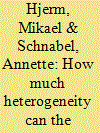

|
|
|
|
|
| Publication |
2012.
|
| Summary/Abstract |
Cultural and economic heterogeneity is often seen as a major threat to modern welfare states. This article contributes to the discussion of how much heterogeneity the welfare state can endure by theoretically and empirically focusing on the relationship between different levels of national identity and the support for welfare state policies. We analyse the effect of different types of national identity on attitudes towards taxation and redistribution. We show that it is the subjective aspect of national identity, or social cohesion, that in fact matters for predicting attitudes to the welfare state. In comparison, more objective measures of heterogeneity like the inequality of income distribution, language fractionalisation or the percentage of foreign-born individuals do not have any effect on attitudes to the welfare state.
|
|
|
|
|
|
|
|
|
|
|
|
|
|
|
|
| 10 |
ID:
161807
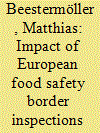

|
|
|
|
|
| Summary/Abstract |
The cost of complying with a sanitary standard is certain. However, such measure introduces uncertainty for exporters in relation to border rejections. Shipments may fail to pass inspections and may be refused entry into the importing country. This risk is shaped by variance in the quality of the exported product, and the stringency of the border controls. We examine how the risk of rejection at European borders on safety grounds is affecting Chinese agri-food exporters. We combine information from the European Rapid Alert System for Food and Feed with Chinese firm-level export data by product, destination and year for the period 2000–2011. Information externalities and reputation effects are important. Border rejections amplify the turnover among firms at the extensive margin of trade. This risk is curbing small exporters and resulting in a concentration of Chinese exports among big exporters.
|
|
|
|
|
|
|
|
|
|
|
|
|
|
|
|
| 11 |
ID:
124919


|
|
|
|
|
| Publication |
2013.
|
| Summary/Abstract |
This article examines the contemporary phenomenon of 'land grabbing' in relation to the history of plantation and large- and small-scale farming (PF, LSF and SSF) in sub-Saharan Africa. It looks at the extent of PF and LSF over the 20th century, as well as the policy narratives that have justified, supported or circumscribed their development. Many characteristics of the current land rush and its interpretation reveal elements of continuity with some of the general trends marking the history of PF and LSF up to recent years. In particular, the heterogeneity of PF and LSF, subsuming quite different relations to SSF, and the pivotal role played by the combination of private capital (whether foreign, domestic or combined) with the state represent organisational continuities. Meanwhile continuities in supporting narratives centre on the prevalence of generic prescriptions for either LSF/PF or SSF. Refuting these generic prescriptions is a precondition for more nuanced analysis and policy proposals.
|
|
|
|
|
|
|
|
|
|
|
|
|
|
|
|
| 12 |
ID:
178883
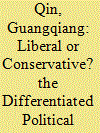

|
|
|
|
|
| Summary/Abstract |
This article analyses data from the 2015 Chinese General Social Survey (CGSS) to investigate the differentiated political values of the middle class in China. Combining the two factors of market situation and institutional division, the article first categorizes several basic types of middle class and then identifies two kinds of political values (liberal and conservative) from the indicators of support for freedom, government satisfaction, and political voting. The results show that the middle class, as a whole, tends to be more liberal than the working class. However, the internal divisions among the sub-groups in the middle class are more obvious – the political tendency of the middle class within the redistribution system is conservative but the middle class sub-groups outside the system, especially the new middle class, have the most liberal tendencies and constitute a potential source for change in China. Thus, the middle class is not necessarily a stabilizer or a subverter of the status quo and has a heterogeneous nature shaped by the dual forces of markets and institutions.
|
|
|
|
|
|
|
|
|
|
|
|
|
|
|
|
| 13 |
ID:
094983
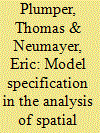

|
|
|
|
|
| Publication |
2010.
|
| Summary/Abstract |
The recent surge in studies analysing spatial dependence in political science has gone hand-in-hand with increased attention paid to the choice of estimation technique. In comparison, specification choice has been relatively neglected, even though it leads to equally, if not more, serious inference problems. In this article four specification issues are analysed. It is argued that to avoid biased estimates of the spatial effects, researchers need to consider carefully how to model temporal dynamics, common trends and common shocks, as well as how to account for spatial clustering and unobserved spatial heterogeneity. The remaining two specification issues relate to the weighting matrix employed for the creation of spatial effects: whether it should be row-standardised and what functional form to choose for this matrix. The importance of these specification issues is demonstrated by replicating Hays' model of spatial dependence in international capital tax rate competition. Seemingly small changes to model specification have major impacts on the spatial effect estimates. It is recommended that spatial analysts develop their theories of spatial dependencies further to provide more guidance on the specification of the estimation model. In the absence of sufficiently developed theories, the robustness of results to specification changes needs to be demonstrated.
|
|
|
|
|
|
|
|
|
|
|
|
|
|
|
|
| 14 |
ID:
175360


|
|
|
|
|
| Summary/Abstract |
This article examines the relationship between place and peace and security in Solomon Islands. Place is understood not only as a geographical location, but as a social, material and symbolic arena where constructions of what constitutes peace and security are continually remade. Place-based constructions of peace and security challenge pervasive spatial assumptions which underpin dominate security discourses about post-conflict Solomon Islands, assumptions which view security as a public good delivered by centralised state institutions to the peripheries. Employing a case study of one particular place, the Gela Group of Islands, this article describes place-based practices, processes, institutions and ideals of peace in contrast to a state ideal of security and argues that far from existing in separate spaces, both place-based and state-based forms of security are in constant interaction and shape each other over time. This article suggests that a way forward in increasing peace and security outcomes in Solomon Islands is to focus on the relationship between place-based forms of security and the state. Doing so acknowledges the political, relational and spiritual worlds of people of place, worlds which fundamentally shape peace and livelihood outcomes, and which require a different understanding of the spatial make-up of the state.
|
|
|
|
|
|
|
|
|
|
|
|
|
|
|
|
| 15 |
ID:
157910


|
|
|
|
|
| Summary/Abstract |
Unequally distributed resources are ubiquitous. The decision of whether to promote competition or equality is often debated in societies and organizations. With heterogeneous endowments, we let subjects collectively choose between a public good that most benefits the less endowed and a lottery contest in which only one individual in a group receives a prize. Unlike standard theoretical predictions, the majority of subjects, including a substantial number of subjects who believe that their expected payoffs are better in the contest, vote for the public good. Our data suggest that people’s collective institutional choices may be driven by inequality-averse concerns. It also suggests that the collective decision to select the option for the public good depends on voting rules.
|
|
|
|
|
|
|
|
|
|
|
|
|
|
|
|
| 16 |
ID:
131897
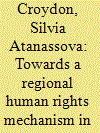

|
|
|
|
|
| Publication |
2014.
|
| Summary/Abstract |
Stretching a third of the way around the globe, the Asia Pacific is the world's most populous region. Yet, it remains the sole region without a human rights court or commission, and without a human rights treaty. The notable absence there of a human rights mechanism based on such institutions is often explained away by reference to the region's size and heterogeneity, the constituent states' reluctance to interfere in the affairs of others, and the existence of rivalries. Whilst agreeing that there is no inter-governmental initiative that looks set to change the present state of affairs in the Asia Pacific, this article places the spotlight on another model of creating a regional human rights mechanism, that is, the unique and burgeoning Asia Pacific Forum of National Human Rights Institutions. Specifically, it assesses the prospects for Japan, Taiwan and China - three key regional players whose membership of the Forum is still outstanding - to create domestic human rights bodies that eventually join.
|
|
|
|
|
|
|
|
|
|
|
|
|
|
|
|
| 17 |
ID:
131005
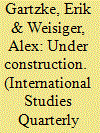

|
|
|
|
|
| Publication |
2014.
|
| Summary/Abstract |
The widely documented dyadic democratic peace observation has led to optimism that the spread of democracy might prove pacifying even outside of democratic dyads. Yet, tensions between the logic of liberal peace in dyads and systems suggest that economic development may be better suited than democracy as a determinant of systemic liberal peace. In particular, regime type heterogeneity (difference) stands to increase conflict at the system level. We argue that there exists a systemic developmental peace, in which increased wealth encourages powerful developed nations to discourage other countries from fighting, even as these same developed states continue to use force in service of their own private objectives. We also separate out the effects of aggregate democracy from regime type difference in our analysis. Systemic and cross-level statistical tests support the following propositions: greater systemic development encourages peace, difference propagates war, and increased systemic democracy has no consistent impact on interstate conflict.
|
|
|
|
|
|
|
|
|
|
|
|
|
|
|
|
| 18 |
ID:
150365


|
|
|
|
|
| Summary/Abstract |
To the extent that demand response represents an intentional electricity usage adjustment to price changes or incentive payments, consumers who exhibit more-variable load patterns on normal days may be capable of altering their loads more significantly in response to dynamic pricing plans. This study investigates the variation in the pre-enrollment load patterns of Korean commercial and industrial electricity customers and their impact on event-day loads during a critical peak pricing experiment in the winter of 2013. Contrary to conventional approaches to profiling electricity loads, this study proposes a new clustering technique based on variability indices that collectively represent the potential demand–response resource that these customers would supply. Our analysis reveals that variability in pre-enrollment load patterns does indeed have great predictive power for estimating their impact on demand–response loads. Customers in relatively low-variability clusters provided limited or no response, whereas customers in relatively high-variability clusters consistently presented large load impacts, accounting for most of the program-level peak reductions. This study suggests that dynamic pricing programs themselves may not offer adequate motivation for meaningful adjustments in load patterns, particularly for customers in low-variability clusters.
|
|
|
|
|
|
|
|
|
|
|
|
|
|
|
|
|
|
|
|
|